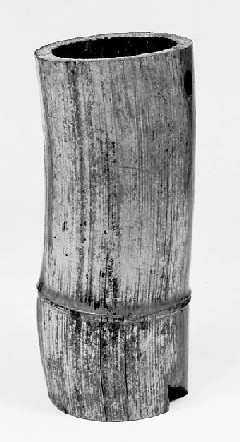| architecture |
| calligraphy |
| ceramics |
| clothing |
| comics |
| gardens |
| lacquerwork |
| literature |
| movies |
| music |
| painting |
| poetry |
| sculpture |
| tea ceremony |
| television |
| theatre |
| weaponry |
| thematic routes |
| timeline |
| the site |
context: tea ceremony > history > Rikyu
Rikyu's Aesthetics

|
Rikyu's bamboo vase from about 1590, called Shakuhachi |
Rikyu followed on from Shuko by going even further with the simple, modest, minimal aesthetics. This meant smaller tea rooms - he favoured 2 or even 1.5 tatami (27 square feet), down from Shuko's 4.5. It meant a garden with a path leading to the tea hut, with everything designed to induce exactly the right mental state in the guests. It meant less showy ceramics, and indeed he directed the origins of Raku ware. It meant that there would be only one object in the tokonoma alcove - a single calligraphy or painting, or a single flower in a vase. It meant making the ceremony about natural movements, without any showiness.
Much of this relates to Zen ideas and aesthetics, already in place in Zen painting. My description of Zen aesthetics. The Rikyu tea ceremony embodies every one of the ideas mentioned there, with the exception of the end notes about humour, which seems not to have a place here at all.
Rikyu's way of tea has been THE way for most of the time since. His championing of Raku ware changed the aesthetics of ceramics. Flower arranging, ikebana, still has its lavish side, but the austere artistry of Rikyu's work (there's a legendary story centring around a single morning glory in a bamboo vase, perhaps the one shown here) has been a major strand since his time. He redefined how a tea room should be, and how the garden around it would work. Speaking broadly, he brought Zen aesthetics from Zen painting and calligraphy into the mainstream of Japanese thinking, and with Raku ware he started the worship of the imperfect that has been central to Japanese aesthetics ever since.
It should also be noted that alongside this, Rikyu hosted lavish tea parties for Hideyoshi, and conducted ceremonies in Hideyoshi's absurd golden tea room - entirely gilded, and using golden utensils. He worked for the most powerful man in Japan, and compromises were sometimes unavoidable.
